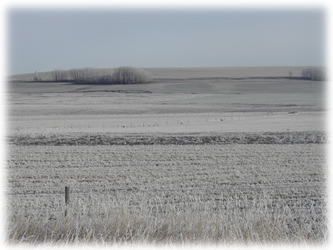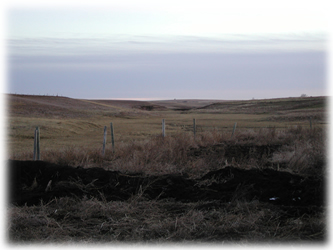| Drought is a complicated
issue; it is not simply a matter of too little rain. It involves evaporation,
transpiration, ground water and snowfall. As farmers say, you don't
lose your crop in January.
| |
|
| Koester Farm - The frozen
fields look abandoned in the winter. |
Koester Farm - This
fence line separates rich pasture land and the coulee from the corrals. |

Our Roots RESOURCES

ROCKYFORD RESOURCES
- Bindloss Pioneer
Committee. (1963). Golden memoirs, 1912-1963. Medicine Hat,
Alberta: Val Marshall Printing.
- The Historical Society has endeavored to preserve the family and
district histories of an area of 540 square miles, extending north
from the South Saskatchewan River, along the border between Alberta
and Saskatchewan for 30 miles and west through ranges 1,2 &3.
Each chapter is a personal recollection of each family. The book is
in celebration of the 50th Anniversary of the district.
- Hay, Muriel.
(1986). Carbon: our history, our heritage. Carbon, Alberta:
Carbon Historical Committee.
- A community history book of Carbon, honoring the early ranchers,
coalminers and homesteaders who settled in the area, beginning in
1890.
- Jewish Historical
Society of Southern Alberta. (1996). Land of promise: the Jewish
experience in Southern Alberta. Calgary, Alberta: Author.
- This book covers the Jewish experience in Southern Alberta up to
and through WW II. The photographs in the book are even more representative
of this historical time period. The first section of the book provides
a brief historical background and is followed by sections dedicated
to many aspects of Jewish life. The book concludes with a section
on family histories.
- Jones-Hole,
JoAnn. (2000). Calgary Bull Sale, 1901-2000. Calgary, Alberta:
Circle V publishing.
- This book is a celebration of 100 years of the Calgary Bull Sale.
The early breeders are featured, from 1901-1950. From 1951-2000, main
events, changes of each decade and some of the most successful breeders
of each period are featured.
- Short Grass
Historical Society. (1974). Long shadows: a history of shortgrass
country. Bow Island, Alberta: Author.
- The material in this book is based on old-timers’ stories,
records and research into various organizations. It describes the
way of life in early Southern Alberta.
- Standard Historical
Book Society. (1979). From Danaview to Standard. Standard,
Alberta. Author.
- A community history book describing life for the people who settled
in Standard, Alberta.
ABOUT CAPTAIN JOHN PALLISER AND THE
PALLISER EXPEDITION
- The
Applied History Research Group. (1997). Palliser’s Triangle.
Calgary, Alberta: University of Calgary. Retrieved June 9,2003,
from http://www.ucalgary.ca/applied_history/tutor/calgary/triangle.html
- Description of the characteristics of the area in Southern Alberta
and Saskatchewan that is called Palliser’s Triangle.
- Francis, D.,
Guitard, M., Heindenreich, C., Janzen, O. (n.d.). John Palliser
and Henry Hind: Scientific Surveying. Pathfinders and Passageways:
The Exploration of Canada website. Retrieved June 9, 2003, from
http://www.nlc-bnc.ca/2/24/h24-1850-e.html
- Outlines the two separate “scientific” expeditions
to inform Great Britain of populations and fauna, of the potential
for roads and navigable waterways and of the possibilities for farming
and mining.
- More
background on the Palliser expedition. (n.d.). Our Heritage website.
Retrieved June 9,2003, from http://www.ourheritage.net/hector_pages/Palliser_bkgd_expanded.html
- Provides a more detailed account of John Palliser’s one-man
expedition to explore the British prairies and find out if there was
any rail through the Rocky Mountains.
- Stanford,
Edward. Palliser’s map of North America, 1865. (n.d.). The
Canadian West Virtual Exhibition. National Archives of Canada.
Retrieved June 9, 2003 from http://www.archives.ca/05/0529/052910/05291024_e.html
- Outlines the lasting contributions of the Palliser expedition in
Canada, and in particular, how the “Palliser Triangle”
was named.
EARLY HISTORY
- The
Applied History Research Group. (1997). Agriculture. Calgary,
Alberta: University of Calgary. Retrieved June 9,2003, from http://www.ucalgary.ca/applied_history/tutor/calgary/agriculture.html
- Describes the agrarian settlement in Southern Alberta.
CLIMATE AND AGRICULTURE
- Agriculture
and Agri-Food Canada. (n.d.). Need for continuing research programs.
Retrieved June 9, 2003, from http://collections.ic.gc.ca/agrican/pubweb/hs80022.asp
- This document outlines the implications of research as it relates
to the Palliser Triangle. As a result of research and ingenuity it
has been possible to sustain production in this region. For the Palliser
Triangle to be competitive with the advancing technologies of other
countries, continuing research programs are needed. Research and development
must be reinforced by detailed up-to-date studies of climate, soil,
management systems, and the economic implications of these systems.
- Bonkiowsky,
L.N. (Ed.), (n.d.). Drought in Palliser’s triangle.
Retrieved June 9,2003, from http://thecanadianencyclopedia.com/index.cfm?PgNm=ArchivedFeatures&TCE_Version=A&FeatureId=20
- This document describes the history of how farming began in the
Palliser Triangle and how devastating droughts have been to this area.
- Brun, S.E.,
(n.d.). Part 2: Natural hazards in Canada: Atmospheric, hydrologic
and geophysical hazards. Retrieved June 9, 2003, from http://www.utoronto.ca/env/nh/pt2ch2-3-1.htm
- Various hazards to which Canadians are exposed are overviewed,
in terms of their impacts, their physical causes and their frequency
of occurrence. This article refers specifically to the impact that
droughts have on Canada.
- Jensen,
R., (n.d.). Early history of climate and agriculture. Retrieved
June 9, 2003, from The Applied History Research Group. (1997). Palliser’s
Triangle. Calgary, Alberta: University of Calgary. Retrieved June
9,2003, from http://www.ucalgary.ca/applied_history/tutor/calgary/triangle.html
- Outlines the various farming methods used in the Palliser Triangle
from 1896 to 1946.
- Palliser
triangle global change project. (n.d.). Natural Resources Canada.
Retrieved June 9, 2003, http://sts.gsc.nrcan.gc.ca/page1/clim/palliser/
- Introduces a collaborative, multidisciplinary research project
to evaluate the impacts of climate on the land and water resources
of the Palliser Triangle.
|


